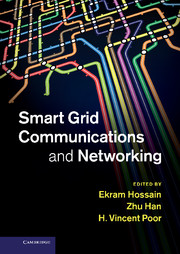Book contents
- Frontmatter
- Contents
- List of contributors
- Preface
- Part I Communication architectures and models for smart grid
- Part II Physical data communications, access, detection, and estimation techniques for smart grid
- 5 Communications and access technologies for smart grid
- 6 Machine-to-machine communications in smart grid
- 7 Bad-data detection in smart grid: a distributed approach
- 8 Distributed state estimation: a learning-based framework
- Part III Smart grid and wide-area networks
- Part IV Sensor and actuator networks for smart grid
- Part V Security in smart grid communications and networking
- Part VI Field trials and deployments
- Index
8 - Distributed state estimation: a learning-based framework
from Part II - Physical data communications, access, detection, and estimation techniques for smart grid
Published online by Cambridge University Press: 05 January 2013
- Frontmatter
- Contents
- List of contributors
- Preface
- Part I Communication architectures and models for smart grid
- Part II Physical data communications, access, detection, and estimation techniques for smart grid
- 5 Communications and access technologies for smart grid
- 6 Machine-to-machine communications in smart grid
- 7 Bad-data detection in smart grid: a distributed approach
- 8 Distributed state estimation: a learning-based framework
- Part III Smart grid and wide-area networks
- Part IV Sensor and actuator networks for smart grid
- Part V Security in smart grid communications and networking
- Part VI Field trials and deployments
- Index
Summary
Introduction
The present-day electricity grid is rapidly evolving towards a complex interconnection of distributed modules equipped with a broad range of heterogenous sensing and decision-making functionalities. The proliferation of highly intermittent small energy resources and changing customer needs highlight more adaptive and responsive grid operability in terms of decision making and control. Conventional grid-controlling techniques are unable to cope with such dynamics, as manifested by the increasing reliance on faster time-scale control (such as FACTs devices which enable power electronics-based switching [1]) and system sampling techniques (such as PMUs [2]) to mitigate rapid system fluctutions. It is hard to overemphasize the role of reliable system state estimation on the efficient operability of current and future grid-control techniques.
The complexity in estimator design stems mainly from the fact that, unlike conventional scenarios, the smart grid state estimator needs to possess the attributes of being distributed, adaptive, and accurate over relatively short time intervals. The design of distributed inference and decision-making tasks is indeed key to sustaining the evolving demands and functionalities of the grid [3–9]. Due to the sheer size of the network (at both the transmission and distribution levels), it will no longer be feasible to communicate the entire raw measurement data from all points at all times to a centralized SCADA for state estimation and control; rather, the various substations or regional transmission organizations (RTOs) should use the cyber or information processing/exchange layer efficiently to compute estimates and controls in a distributed manner.
Information
- Type
- Chapter
- Information
- Smart Grid Communications and Networking , pp. 191 - 202Publisher: Cambridge University PressPrint publication year: 2012
Accessibility standard: Unknown
Why this information is here
This section outlines the accessibility features of this content - including support for screen readers, full keyboard navigation and high-contrast display options. This may not be relevant for you.Accessibility Information
- 3
- Cited by
